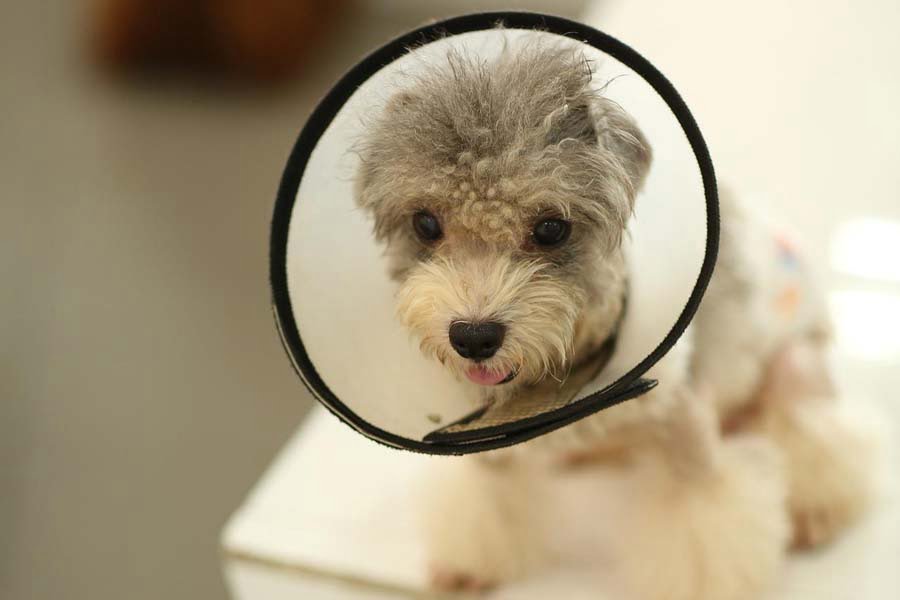A Turramurra Pet Care Article
Desexing Your Pet

Desexing Your Pet
by Dr Gretta Howard, Senior Veterinarian
Unless you’re a breeder, desexing is an important part of being a responsible pet owner. The benefits of desexing far outweigh the risks but the right timing is important. Apart from reducing the number of unwanted puppies or kittens, the benefits of desexing range from avoiding unwanted testosterone-related behavioural traits to medical problems later in life.
What is desexing?
Desexing is a routine operation performed under general anaesthesia and involves removing the ovaries and uterus from a female (known as ovariohysterectomy or ‘spay’) or the testicles (known as castration) in males.
When should desexing be performed?
Most councils offer a reduced fee for registering desexed pets provided they are desexed by 6 months of age (dogs) or 4 months (cats). If the council recommends an earlier desexing age than what we have advised below, then we can provide you with a desexing exemption certificate signed by your vet at your puppy or kitten vaccination appointment advising the council of the age we have recommended desexing be performed.
When to desex dogs
Dogs
In female dogs, our recommendation is for female dog desexing to be carried out prior to having the first season (also known as ‘heat’). This is because the relative risk of developing mammary cancer increases from almost zero (if desexed prior to her first season) to 8% then 26% if your dog has her first and second seasons prior to desexing, respectively. As the majority of female dogs come into heat just after 6 months of age, our recommendation is to desex all female dogs at 6 months of age.
In male dogs, desexing age is dependent on the expected time that bony growth plates will close, which correlates with expected adult weight. This varies from 6 months of age in small breeds of dog e.g. Chihuahuas, to 18 months of age in giant dog breeds e.g. Great Danes. There is now some evidence to suggest that certain orthopaedic problems, such as cruciate ligament rupture, is less likely if desexing is delayed until expected growth plate closure. Dachshunds are predisposed to spinal problems due to intervertebral disc disease, so for this particular breed, the recommended age to desex male Dachshund dogs is 12 months.
| Expected adult MALE dog weight | Recommended MALE dog desexing age |
| < 20kg | 6 months |
| 20-30kg | 12 months |
| 30-40kg | 15 months |
| >40kg | 18 months |
| Dachshunds | 12 months |
When to desex cats
Cats
Turramurra Veterinary Hospital recommends both male and female cats are desexing between 5 and 6 months of age. This age means they are big enough to avoid hypothermia (low body temperature) under anaesthesia, and prior to sexual maturity.
When to desex rabbits
Rabbits
Rabbits should be desexed at approximately 6 months of age. The exception to this rule would be if there is both a male and a female rabbit living together. In these situations, we would recommend desexing the male bunny earlier, between 3-4 months of age, provided they were at least 1kg in body weight, or separating them until desexed to avoid an unwanted pregnancy.
What are the benefits of desexing?
Benefits of desexing dogs
Dogs
Desexed male dogs tend to display less problem behaviours including:
- Urine marking
- Inter-dog aggression
- Sexually-directed behaviours e.g. humping
The top three health benefits from desexing male dogs include:
- Reduced prostate problems e.g. constipation due to an over-sized prostate, prostate infections
- Eliminates risk of testicular cancer and reduces risk of perianal adenoma tumours
- Reduced risk of perineal hernia
The top three health benefits from desexing female dogs include:
- Reduced risk of mammary cancer (almost zero chance if performed before first season)
- Eliminates risk of pyometra (life-threatening infection of the uterus)
- Eliminates risk of ovarian cancer
Benefits of desexing cats
Cats
Desexed male and female cats tend to display less problem behaviours including:
- Urine marking
- Inter-cat aggression
- Roaming behaviour
The top three health benefits from desexing male and female cats include:
- Reduced risk of contracting Feline Immunodeficiency Virus (FIV) through fighting due to territorial aggression
- Reduced risk of trauma due to being hit by a car on the road due to less roaming
- Eliminates risk of pyometra (life-threatening infection of the uterus), ovarian cancer, testicular cancer and reduces risk of mammary cancer
Besides the health benefits to the individual cat, unless you are a registered breeder, from an environmental perspective, it is important to desex pet cats due to the impact that the feral cat population has on our native wildlife. This includes indoor cats, as there is always the potential for escape.
Benefits of desexing rabbits
Rabbits
Apart from the obvious avoidance of unwanted pregnancy, desexing both male and female rabbits can be beneficial from both a behavioural and medical stand point.
Desexed male and female rabbits tend to display less problem behaviours including:
- Urine marking
- Aggression
The top 3 health benefits for desexing female rabbits include:
- Prevention of uterine cancer
Up to 70% of female rabbits develop life-threatening cancer (adenocarcinoma) of the uterus if they are not desexed - Prevention of false pregnancy
Female rabbits can go into a pseudopregnancy triggered by hormones from the ovaries, which means the body acts as though it is pregnant but no babies are produced, which can be very stressful for the rabbit - Prevention of mammary (breast) cancer
Prior to Surgery
What do I do to prepare my pet for a desexing procedure?
Fasting
Dogs and cats need to be fasted from 9pm the night before, but you can leave them with their water overnight, just remove their water bowl first thing in the morning.
Rabbits do not need to fast as they cannot vomit. As they are hindgut fermenters, they need to keep eating frequently in order to prevent gut stasis, which can be dangerous, so it is important that rabbits are fed even on the morning of their surgery and as soon as they recover. Owners should bring in their rabbit’s regular food to offer their regular diet in the post-operative period.
Hygiene
Surgery needs to be performed in a sterile environment, which is usually fine for dogs and rabbits as they are fairly fastidious groomers, but some dogs may need a bath the day before their surgery so they are clean when they come in.
Toileting
Dogs will need a toilet walk at home prior to their admission time and again just before coming into hospital to empty their bladders. Cats and rabbits will toilet as usual in their litter box while they are awaiting surgery.
Consent
Prior to your pet’s desexing appointment, you will be sent an SMS with a link to a consent form, which is a legal requirement before an animal is admitted for a general anaesthetic. If you have trouble accessing the link, then a manual consent form can be filled out at admission.
What is the admission process for my pet?
Admission time
Admission for surgery is between 7.30am – 8.30am. The earlier your pet can be brought in, the earlier we can get underway with surgery, which means less waiting time for your pet, an earlier recovery time and of course a meal. An earlier admission time can be organised by prior arrangement if required.
A Customer Care team member will greet you and your pet on arrival and ensure the consent form has been completed, then bring your pet into our hospital area where he or she will be greeted by the surgery team.
Phone call
The veterinary surgeon performing your pet’s desexing operation will call you prior to starting your pet’s surgery, which allows any further questions you may have to be answered prior to going ahead as well as any abnormal physical examination findings. You can expect the vet to phone you between approximately 8am and 11am. A discharge time for your pet may be booked at this time and the estimate discussed if this has not already been done.
Will my pet have a blood test before desexing?
Dogs and cats routinely have a blood test called a PCV/TPP at the time their catheter is placed, which identifies patients with a low red blood cell count or protein level prior to surgery. This only requires a few drops of blood to run. In addition to this, one of the consent form questions is to ask you whether you would like a pre-anaesthetic blood test, which in addition to the red blood cells, also checks the white blood cells, platelets, glucose level, kidneys and liver prior to an anaesthetic. This test is an optional test for owners who wish to know a bit more about their pet’s health prior to undergoing desexing surgery. Learn more about the benefits of a pre-anaesthetic blood test here.
What happens to my pet once they are admitted into hospital for desexing?
Physical examination
After admission, your pet is examined by the veterinary surgeon performing the desexing surgery. Your pet’s heart rate and rhythm are assessed as well as hydration status, to ensure they are physically fit for surgery.
Premedication
After a physical examination, your pet is giving a premedication or ‘premed’ which is an injection containing pain relief and a relaxant. This serves to both reduce any anxiety relating to being in hospital, reducing the dose of anaesthetic required and pre-emptively administering pain relief so that your pet has a smooth, pain-free recovery.
Intravenous catheter placement
An intravenous catheter is placed into the cephalic vein on your pet’s fore limb. This is used to administer the anaesthetic induction agent and then intravenous fluids during surgery. Having intravenous access is vital for safety purposes and also to adjust the depth of anaesthesia during the operation to an ideal level.
What other procedures may be recommended at the time of desexing?
Desexing provides an opportunity for pet owners to inform their vet of any health concerns that can be assessed during the physical examination.
Retained juvenile canine tooth extraction (common in dogs)
Sometimes deciduous canine teeth do not fall out by the time the adult tooth erupts, causing problems with bite alignment. Your vet will inform you if your puppy has retained juvenile teeth that require extraction.
Proheart injection (dogs)
If your dog is getting desexed at 6 months of age, then this also the recommended age to give the annual Proheart injection to protect your dog from heartworm disease. Giving an annual Proheart injection will allow your dog to switch from a monthly preventative program to only needing to administer an intestinal wormer (Milpro or Drontal) and a tick and flea preventative (Bravecto chew) every 3 months. Most clients prefer to only have to administer a preventative 4 times per year rather than 12.
Anal gland expression (dogs)
If your dog is prone to ‘scooting’ on their bottom, then while your pet is under anaesthesia, your vet can express the anal glands, which can become impacted and irritated. This procedure can be performed while conscious in the future as needed.
Nail clipping
Nail clipping is complimentary for all patients undergoing desexing so if you would like this done, remember to request this over the phone or on the consent form.
Desexing Procedure
Where is my pet’s surgery performed?
At Turramurra Veterinary Hospital, our surgical theatres are of a human-standard hospital, including state of the art equipment and surgical standards. A HEPA filter (high efficiency particle arrestor) provides pure filtered air to the operating theatre and all instruments are autoclaved ensuring maximum surgical sterility. Veterinary surgeons are fully scrubbed up, gowned and gloved to human hospital standards, which is why our practice has one of the lowest rates of post-operative infections. These are not standard requirements for all veterinary practices, but we have chosen to perform surgery this way because it leads to the best patient outcomes.
How is an anaesthetic monitored at Turramurra Veterinary Hospital?
Induction and intubation
The anaesthetic induction agent is given through an intravenous catheter and then a tube is placed into the pet’s trachea (endotracheal tube). This ensures that the airway remains open at all times. A mixture of oxygen and anaesthetic gas is then breathed in through an anaesthetic machine during the operation. A qualified veterinary nurse can give extra breaths as required manually through a rebreathing bag to keep the oxygen at an ideal level.
Intravenous fluids
Your pet’s blood pressure and hydration status is maintained by routine use of intravenous fluids during surgery, which in turns reduces recovery times because by administering fluids throughout the anaesthetic, the kidneys and liver are properly perfused, allowing fast metabolism of the anaesthetic agents.
Blood pressure
Blood pressure is measured throughout surgery and fluid rates and anaesthetic levels adjusted accordingly.
Pulse oximetry
Pulse oximetry allows the oxygen levels in the blood to be monitored in real time with every heartbeat.
Capnography
The capnograph analyses the exhaled breath of your pet to check what carbon dioxide levels are present. This is the most sensitive way to detect any ventilation issues and allows extra breaths to be given manually to keep ventilation optimal.
Temperature
Temperature is monitored closely during and after desexing and patients are kept warm with a circulating warm air blanket called a Bair Hugger as well as heated surgery tables.
What time will my pet have the surgery and how long does it take?
Turramurra Veterinary Hospital performs dog desexing as a day surgery, which means your pet can go home in the afternoon. Surgery is usually started at 8.30am and finished by 1pm. Timing may vary pending emergencies that present on the day.
Sterile procedures, such as desexing surgery, is usually performed prior to non-sterile procedures, such as dentistry, for hygiene reasons.
Desexing cats is usually very efficient, with male cats taking approximately 20 minutes and female cats 40 minutes. Desexing rabbits usually takes approximately 45 minutes for males and females. Desexing dogs is more variable depending on age and size, ranging from 30 minutes in male dogs to 60 minutes in female dogs. It is the patient preparation and recovery period that is more time consuming than the actual surgical time.
More complicated desexing procedures such as cryptorchid castrations (where one testicle has not descended into the scrotrum) can take between 1-2 hours.
What pain control is administered to my pet to keep them comfortable?
In addition to the premedication discussed above, all pets receive a pain relief injection in the post-operative period. Cats usually receive a pain relief injection, which lasts up to 12 hours, whereas dogs and rabbits receive a non-steroid anti-inflammatory pain relief injection (meloxicam) which lasts 24 hours.
Oral meloxicam is dispensed for female cats and both male and female dogs for 3 days post-operatively. It is important to administer this with food and not if your pet is not eating. Male cats recover swiftly and generally do well with the single injection given in the clinic.
Pain relief is included in the cost of desexing.
Will my pet be fed when they wake up?
As soon as your pet has recovered from the anaesthetic and able to move around independently in the cage, your pet will be offered an easily digestible meal. Rabbits need to be fed immediately after they wake up to reduce the risk of gut stasis, so bringing in the food they are used to from home is preferred.
If your pet is on a special diet or is particularly fussy, you are welcome to bring in a meal in a labelled container for your pet to have after surgery.
Home Care
When can my pet go home?
Discharge time is usually between 3-5pm depending on the pet’s recovery progress and the owner’s availability in the afternoon. We are open until late evening and are happy to cater to the discharge time that best suits you and your pet. Where possible, the vet that performs the surgery is the same vet that discharges the patient. This allows for continuity of care and for any questions to be answered about the surgery and recovery at the time of discharge. For late patient discharge requests, your vet may do a phone discharge in the afternoon to go through instructions with you and then book you in with a nurse or a different vet in the evening.
How should I care for my pet at home after desexing?
Your pet should be kept close to you during the first evening after arriving home so you can make sure they are comfortable, warm and provided with soft bedding and fresh water.
Avoid picking your pet up unnecessarily as this may disturb the wound and cause discomfort.
Always check the wound daily for any complications but unless directed by your vet, there is no need to clean or dress the wound. Wounds heal from side to side not lengthways, so regardless of the length of the wound, the healing time will be the same, with inflammation reducing and wound strength building daily.
Remember to administer any prescribed medications as directed on the label and if there is any confusion, call for clarification.
Pets should also be monitored to ensure they are toileting normally within the first 24 hours. Rabbits are at an increased risk for gut stasis, which is when the intestinal tract stops functioning properly and faeces are not produced, putting them at risk. So make sure you remove all the faeces from their living area before returning home with your bunny, so that this can be closely monitored.
If there are any questions or concerns about your pet during the recovery period, we are only a phone call away and you are welcome to book in for a complimentary wound check with one of our vets.
How do I prevent my pet from licking the surgical site?
All dogs and female cats are given an Elizabethan collar to wear at home to prevent access to the surgical site. Not all dogs and cats will lick their wound, so when you first arrive home, keep your pet close to you and observe their behaviour to see whether wound licking is likely. If he or she is interested in the wound, then it is safest to apply the Elizabethan collar for the first 5 days post-operatively, which is when the majority of the healing occurs.
If your pet does not tolerate the collar then there is a spray called Wound Guard which is a bitter-tasting disinfectant that can be sprayed directly onto the wound twice daily to deter pets. This is available to purchase at Turramurra Veterinary Hospital.
Male cats do not need to wear one as their incision sites are tiny and there are no sutures present. Rabbits don’t generally tolerate them.
Can I still exercise my dog after surgery?
Rest is important when recovering from surgery, so it is important to keep your pet quiet for the next few days. Generally, for the first 3 days post-operatively, exercise should be avoided, but your dog can still be taken outside for toilet walks as per usual. By Day 4, dogs are usually keen to get out and about again for a short leash walk. Vigorous off leash play is not recommended until after you have had the vet’s all clear during your dog’s post-operatively recheck appointment.
Are there any potential wound complications to look out for?
Desexing is a routine procedure and while uncommon, like any surgery, complications are possible. Some possible complications include:
- Skin irritation
- Prior to surgery, the surgical site is clipped and antiseptic applied to keep the surgical site sterile which can sometimes cause irritation
- The fore limb is also clipped prior to intravenous catheter placement can be a source of irritation
- If your pet has had a pre-anaesthetic blood test, then the area under the neck where the blood was drawn should be monitored for a rash
- Wound breakdown
- Premature removal of sutures by your pet leading to wound breakdown
- Post-operative wound infection
- Signs include a discharge and redness
- Post-operative pain
- Sometimes additional pain relief is required if your pet appears to be reluctant to move around normally or appears uncomfortable
- Diarrhoea
- Diarrhoea post-operatively is common and should be reported to your vet if it persists for > 24 hours so that appropriate advice and treatment can be given
- If pain relief has been dispensed to be given at home, then this may be contraindicated with diarrhoea and an alternative may need to be organised
- Vomiting
- Vomiting after surgery is not normal and should be reported to your vet urgently
- Not eating
- The majority of pets will eat something on the day they arrive home and about most will have already eaten at the hospital during recovery
- If your pet is not eating by the next morning, this should be reported to your vet
If you are concerned about your pet or if they develop any of these signs, please phone and speak with one of our friendly nurses or book in for a complimentary post-operative recheck promptly.
Post-operative Examination
Do I need to return for a post-operative exam for sutures to be removed?
With the exception of male cats, pets that have been desexed will need to be brought back for a post-operative recheck. External skin sutures can be removed between 10-14 days post-operatively. If intra-dermal sutures have been placed instead of external sutures, the wound should be re-examined in 7 days. This appointment should be booked in when your pet goes home and for continuity, it is best to book in the post-operative exam with the veterinary surgeon who performed your pet’s desexing surgery.


